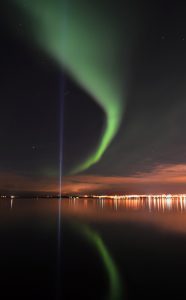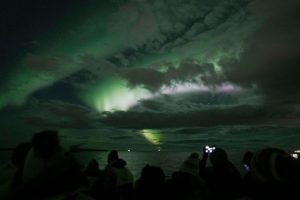Things to know for your Northern Lights by Boat Adventure
So, you’ve made your decision. You’re going to cross something major off your bucket list and go on a hunt for the Northern Lights. And best of all, you’re travelling to Iceland, the most beautiful country in the world! (Of course, I might be a bit biased.) My name is Jonathan Rempel, and I’m the Head Guide at Special Tours, the longest-running boat tour company in Reykjavík, Iceland. I’m now entering my 3rd winter of guiding Northern Lights by Boat tours here, and although I like to think I’ve seen it all, the fact is that these tours surprise and excite me in new ways all the time. I wanted to share some information and tips with you that might help you in your hunt.
When can I see the Northern Lights in Iceland?
First of all, in order to view the Northern Lights, the conditions must be right. You must have skies that are at least partially clear, as too many clouds can cover the Northern Lights up and make them impossible to view. It must also be dark enough to see them – and in Iceland, it doesn’t get dark at night in the summer! To be able to see the Northern Lights in Iceland you must visit sometime between late August and late April. When hunting for the auroras, you want to start by escaping any light pollution by leaving towns and cities behind. After that, the rest of the formula is just patience, and luck. The Northern Lights are a completely natural phenomenon, so nobody has any control over them. They are not guaranteed, as they can vary, just like the weather.


Northern Lights tour options
There are so many ways to try and see the Northern Lights in Iceland. Countless companies offer bus tours, or you could rent a car and hunt for them yourself. And then there’s us – we take to the seas to hunt for the aurora. But why should you consider taking a boat to see them? Well, in a few words, it’s way more fun.
The fact of the matter is, the chance to see auroras from the sea is not higher than on land. In fact, the chances are usually very similar. But to see why being on a boat is better, imagine the following situation: You’re on a bus tour to see the Northern Lights. You board the bus in Reykjavik with 70 other people, and drive for 1-2 hours to leave the city. During that time, you’re stuck in your seat, and you can’t go outside until you reach the destination. Once you get there, finally you can stretch your legs, breathe deep, and hopefully enjoy the show… before having to be stuck in your seat for another 1-2 hours on the way back. And hopefully you dressed warm enough, as well.
Why go hunting for the Aurora Borealis by boat?
Being on a boat with us opens up so many possibilities. We depart from the Old Harbor in Reykjavik, just a 5-minute walk from the city center (but if you’re staying farther away, we offer an optional pickup and drop-off service to major hotels and guesthouses). All our passengers can borrow our wonderful thermal overalls for free, which can make it feel downright cozy when sitting or standing outside. On our way out, you get a chance to view the magnificent Reykjavik city lights and the Harpa concert hall from the sea, which is a great start and end to the tour. We have a cafeteria and a bar on board with a nice variety of snacks and drinks, and plenty of restrooms. You are always free to move around anywhere you wish, inside or outside, from the moment you step on board. And the best part – every tour comes with a fantastic and experienced guide to tell you all about the science and magic behind the Northern Lights! We aren’t the only company in Reykjavik offering Northern Lights by Boat, but we were the first company in Iceland to do so. That gives us a lot of experience, which we are happy to pass along to you. Plus, being on a boat is awesome! But again, I’m probably biased.

What to bring with you on a Northern Lights by Boat tour?
- Warm clothing is a must. Our overalls are amazing, but you should still have something warm underneath. We recommend thermal base layers, preferably wool or a wool blend, underneath your pants and shirt. If you’re looking for a warm mid layer, I can recommend no better than an Icelandic wool sweater – they are sold in many souvenir shops around the country! A windproof and waterproof jacket on top of the sweater will really trap the heat as well. And don’t forget your gloves and hat.
- Sturdy shoes are important. If you are visiting Iceland in winter, streets and walkways around the city and harbor can be often icy and slippery. So, leave those high heels and Crocs at home. Hiking boots with thick soles will keep you warmer, and more surefooted as well. Our crew always does their best to sand and de-ice the outside decks of the boats and the ramps as well, but weather can change here in Iceland faster than you can say Eyjafjallajökull.
- Your camera must be good enough. Many people watching the auroras prefer to just enjoy the moment, and not worry about taking photos. If you’re one of those people, then fantastic! As I always say, the 2 most important cameras are the ones in your head – your eyes. But if you want to try and capture the auroras on camera to take home some souvenirs, then you must have a camera that supports them.

What kind of a camera to use to photograph the Northern Lights?
The best type of camera to capture the Northern Lights with is a DSLR or mirrorless-type camera – so think Nikon, Canon, Sony, or similar. All too often, I see people bringing small point-and-shoot cameras on these tours, only to be disappointed by the results. The problem is that cameras like these, and most smartphone cameras, have very small sensors that don’t support manual settings. If you really want to try anyway, you could try to set your camera to Fireworks mode, and hope for the best. There are several smartphone apps which could potentially be used to photograph Northern Lights, including Northern Lights Photo Taker, Nightcap, and others. But these depend mainly on your own phone, as they are not all created equal!
Camera settings to photograph the Northern Lights
Here I will go over the best settings for capturing auroras on a camera that can be set to manual mode. The best settings for Northern Lights photography on land will be quite a bit different than on a boat – mainly because the boat is moving! So here are the settings you should use:
- Attach a wide-angle lens. Leave those telephoto lenses behind – the best results come from lenses with a wide angle, so you can get the full scene or landscape with the auroras. Zoom all the way out, if your lens has a zoom capability.
- Set your camera to Manual mode. There should be a wheel or dial at the top of the camera, which should be rotated until it is set to M.
- Raise your light sensitivity, or ISO. Usually, this should be as high as it goes, but I would aim for 6400 at a bare minimum.
- Lower your aperture, or f-stop. This should usually be set to as low as it can possibly go.
- Change the shutter speed. Usually you will want a shutter speed of approximately 1 second. Any longer, and the photos may appear blurry due to the motion of the boat. Any shorter, and the auroras may not come out as bright as you would like.
- Set your focal distance to infinity (∞). Some lenses make this easy, but if you aren’t sure how to do this, the best way is to focus on something very far away, like a mountain or city lights in the distance.
- Set your lens to manual focus. Lenses cannot focus on the Northern Lights, as it simply does not work. So, once your focal distance is infinity, turn off all autofocus. This can often be done with a switch on the lens itself.
Just note that the optimal settings can vary between cameras, and between aurora conditions. I recommend consulting your camera’s user manual for instructions on how to change specific settings if you aren’t sure. During our boat tours, our experienced guides are always standing by to help you out as well, if you need it.

How to read into the Northern Lights Forecast
If you’ve done some research into hunting for the Northern Lights, then you might have heard that aurora activity can be measured using a scale from 0 to 9, called the Kp-index. You may be crossing your fingers extra hard for higher numbers during your trip to Iceland. On most nights, this activity is around a 2, which sounds low when you first hear it. This scale does measure aurora activity, but it could also be described as a way to measure how far south auroras can be seen. The higher the number, the farther south one might view the Northern Lights. And because Iceland is relatively high in latitude – around 64 degrees North around Reykjavik – even very low numbers are enough for nice displays. But the thing is that we don’t pay much attention to those numbers, as we find they are not always a good indicator for how the auroras will appear. For example, I have personally seen stunning displays with swirling green and pink when the Kp-index was a 0 – and we have once gone out when the Kp-index was a 7, and we saw nothing. Your experience can certainly vary.
When our experienced team makes their decision whether to go out or not on a given night, they check several weather forecast websites, with the main one being the official Icelandic Meteorological Office – you can check it out yourself at en.vedur.is. We only ever decide to go out if the chances of seeing the auroras are good – something that we’re very proud of! Because the forecasts for cloud cover can change so quickly, we always make the decision the same day as the tour, and often it will be late in the day, so we can base our decision off the latest forecasts. We usually make our decision around 16:00 (4 pm) each day, so our passengers can plan their evenings with enough notice. If we do decide to cancel due to unfavorable cloud cover, you are always welcome to reschedule for another night.

Free ticket to try again in case of no sightings!
Just remember that the Northern Lights aren’t always there. In a way, that makes them even more special – that they require patience, and hunting. But just in case you come on a tour with us and don’t get lucky with seeing the aurora, then you will receive a free ticket to try again, an offer that never expires. We therefore recommend coming on a tour as early in your vacation as you can – that way, you have more chances to see them. You can book your Northern Lights by Boat tour online, and if you have any further questions related to our tours, feel free to contact our ticket office by email at info@specialtours.is or just call +354-560 8800.
I wish you good luck, and happy hunting!
Jonathan Rempel
Instagram: @jon.rempel
Special Tours Head Guide








